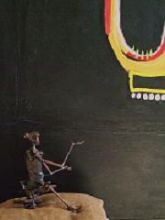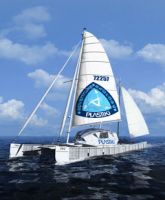Nature by Jumbo
Danish try out grazing elephants on the moors
Latest update: July 4, 2010
 Big grazing animals, like Konik horses and Galloway cattle, can be useful helpers in nature management, nibbling away on annoying growth where open ecosystems are preferred. Danish ecologists went all-out in 2008: they let elephants graze a Danish nature area.
Big grazing animals, like Konik horses and Galloway cattle, can be useful helpers in nature management, nibbling away on annoying growth where open ecosystems are preferred. Danish ecologists went all-out in 2008: they let elephants graze a Danish nature area.
Photo Elephant and protected bluebell: © Jan Kunstman
Faced with the news, outside experts could hardly believe their ears. Headed by ‘nature school’ director Morten Lindhard a small team of ecologists had three elephants grazing the Eskebjerg Vesterlyngen moors in the summer of 2008.
Circus elephants
The dream of ‘rewilding nature’ has a long tradition, both in Europe and the U.S.A. In many European countries grazing cattle, horses, sheep and deer have helped considerably in removing unwanted bushes and trees.
Lindhard got fascinated by the so called megafauna extinction theory about mankind’s extermination of big wildlife in se tone age. Could elephant-like offspring of the famed mammoths still find an ecological niche in modern European ecosystems, he asked himself?
After considerable effort he convinced a German circus family to lend him three Jumbo’s - two Indian and one African forest elephant - and let them roam and graze the Vesterlyngen heather, an area plagued by unwelcome birches, bushes and other growth.
Critical
Says Lindhard: “Although the try-out was short (only three days) and by no means a true scientific experiment, it was a relaxed experience. We observed some interesting behavior and the animals seemed to have a great time.”
Other experts, like the Dutch ‘father of grazing theory’ Frans Vera, are critical. Elephants have never had a place in post Ice Age Europe. No sound ecological need to introduce them now, they say.
But Lindhard remains unconvinced. Modern European nature is totally different from anything we had before, anyway, he says. Maybe zoo and circus elephants could still be useful. And in the process have a vacation from their cramped day-to-day condition! Full story (in Dutch, with link to Danish)…
Martial Art

Once they were bullets, pistols or grenades. Now under the deft hands of Mozambique’s possibly most famous sculptor Goncalo Mabunda they have been transformed into Art.
Recycling AK-47's and other arms from the one-time civil war has become the trade mark of Mabunda and a couple of his fellow artists. I saw some of the results in a small B&B in Antwerp. But even the British Museum and the Bill Clinton Foundation acquired pieces from the 'Arms into Art' programme. Read more…
Photo: © Michel Robles
High on FSC

Ten years ago the Netherlands were an admired environmental pioneer nation. Nowadays, due to a shortsighted neoliberal policy we are almost tail-end Charley within the European Union. Belgium, on the other hand, is a real runner-up. Last December (2010) the Flemish Leukenheide distillery presented Dennenknopje (Pine Bud). Dennenknopje is the world’s very first jenever (traditionally a truly Dutch strong drink), made from a Forest Stewardship Council (FSC) labeled wood product. The gin-like softbooze is distilled from pine cones from the Pinus silvestris. The pines grow in Flanders’ vastest, FSC certified forest region Bosland. A local high from an okay forest. Innovation can be anywhere.…
Questioning Plastiki pride
The newly designed cradle-to-cradle catamaran Plastiki has recently arrived is Sidney after a publicity voyage from California across the Pacific Ocean. The designers claim extreme recyclability. But, contrary to earlier announcements, the ship will not be up-cycled now that it has reached its destination. The builders say they've become too attached to their newborn baby. Of course, the vessel can be a showcase for years to come. But, hey, isn't this kind of attachment of people to their achievements precisely the reason why our earth is becoming such a cluttered place? www.theplastiki.com

Sweet C2C
Cradle-to-cradle handmade beauty: go haunt the town's antique and recycle shops and flea markets for a bunch of elegant (or maybe you prefer funny or modern design) plates, saucers and wine glasses. Wash them well, sand the glasses' brims lightly and glue things together with strong porcelain glue. Any shape, size and design you fancy, will do.


Lo and behold: you have now created your own home grown bonbonnière! For sweets, cookies, fruit - or sandwiches if you like. Ladies love'em! Dozens were sold in a fashion shop in my home town. Enjoy more...

Photos: © Michel Robles
Links
Novio Design Webdesign
